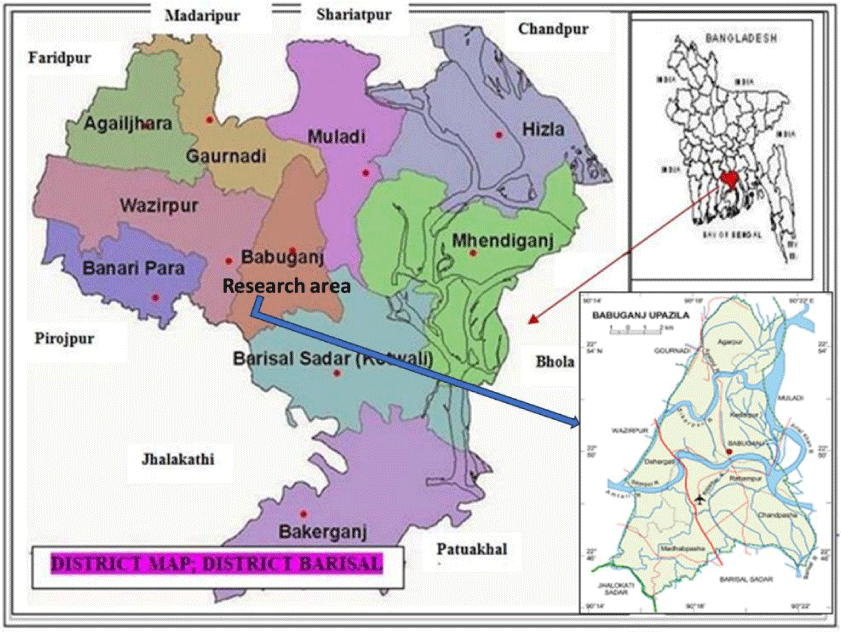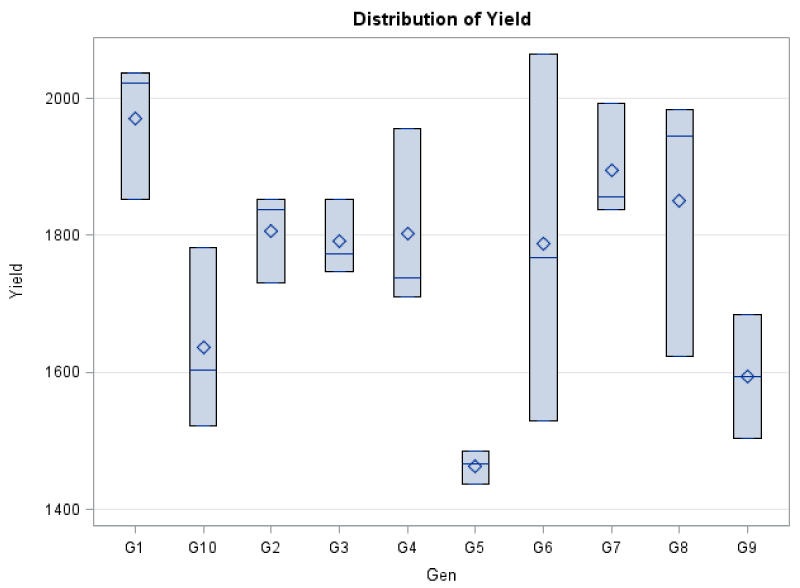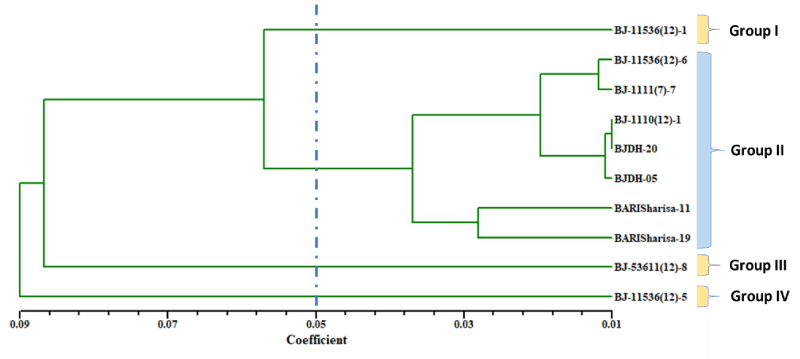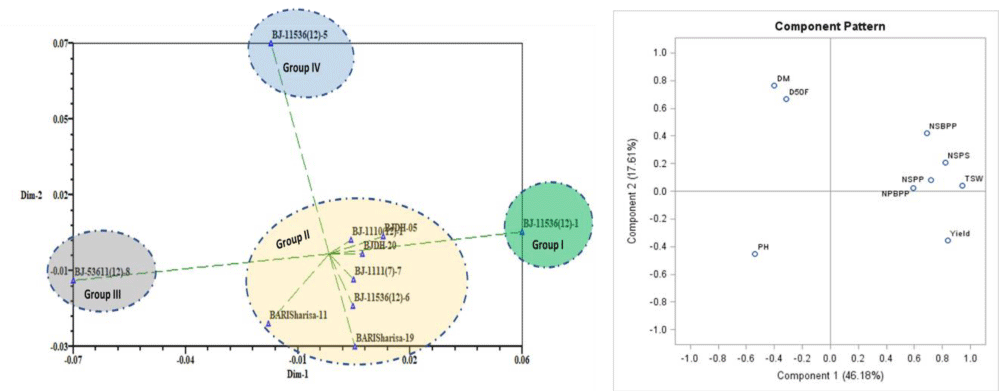International Journal of Agricultural Science and Food Technology
Genetic variability, traits interactions, and principal component analysis of broad-leaf mustard group (Brassica juncea L.) to focus on the yield improvement
Md Mahmudul Hasan Khan1*, BC Kundu2, Suprio Ghosh3, Gazi Nazmul Hasan4, Md Rashidul Hasan Anik5, Md Mainul Islam6, Mst Shamima Yesmin7, Nasira Akter8, Krisna Chandra Saha9 and Md Torikul Islam10
2Varietal Improvement Program, HRC, Regional Agricultural Research Station, BARI, Barishal-8211, Bangladesh
3Plant Breeder, Oilseed Research Center, Bangladesh Agricultural Research Institute, RARS, Burirhat, Rangpur-5400, Bangladesh
4,5On-Farm Research Division, Bangladesh Agricultural Research Institute, Bhola-8300, Bangladesh
6On-Farm Research Division, Bangladesh Agricultural Research Institute, Patuakhali-8602, Bangladesh
7,8Plant Breeder, Regional Horticulture Research Station, Dumki, Patuakhali-8602, Bangladesh
9Plant Breeder, Oilseed Research Center, Bangladesh Agricultural Research Institute, Gazipur-1701, Bangladesh
10Horticulturist, Horticulture Research Center, Bangladesh Agricultural Research Institute, Gazipur-1701, Bangladesh
Cite this as
Hasan Khan MM, Kundu BC, Ghosh S, Hasan GN, Hasan Anik MR, et al. (2023) Genetic variability, traits interactions, and principal component analysis of broad-leaf mustard group (Brassica juncea L.) to focus on the yield improvement. Int J Agric Sc Food Technol 9(4): 104-110. DOI: 10.17352/2455-815X.000200Copyright License
© 2023 Hasan Khan MM, et al. This is an open-access article distributed under the terms of the Creative Commons Attribution License, which permits unrestricted use, distribution, and reproduction in any medium, provided the original author and source are credited.Mustard (Brassica spp.), one of the most important oilseed crops, is currently the third-largest source of vegetable oil in the world. In Rabi, 2022–2023 at the Regional Agricultural Research Station (RARS), Barishal, research of Brassica juncea L. was carried out with 10 genotypes to assess yield and yield contributing features. The RCBD design for the experiment included three replications. Plant height, the number of primary branches, the number of secondary branches, and the number of seeds per siliqua were the characteristics for which the analysis of variance findings indicated that there were very significant differences. Using the UPGMA cluster analysis, four distinct clusters were found among the analyzed accessions. Cluster II obtained the most accessions (7), averaging 1765.28 kgha-1, representing 25.20% of the average group mean yield. A correlation study focuses on the highly significant and positive correlation between a crop’s associated features and its yield. The overall amount of variance was found to be 46.18% for PC1 and 17.61% for PC2 using Principal Component Analysis (PCA). Maturity duration ranged from 106-110 days while the 50% flowering period varied from 43-46 days. Seed yield ranged from 1463 to 1970 kgha-1 and BJ-11536(12)-1 produced the highest yield among the genotypes. Which was it produced 23.58% and 20.41% higher yields than check varieties BARI Sarisha-11 and BARI Sarisha-19, respectively. The second highest yield was recorded from BJDH-05 which produced 18.90% and 15.85% higher yield over the check varieties BARI Sarisha-11 and BARI Sarisha-19, respectively. The lowest seed yield (1463 kgha-1) was obtained from the entry BJ-53611(12)-8. Based on, statistical analysis considering seed yield and other yield contributing characters, four lines BJ-11536(12)-1, BJDH-05, BJDH-20, BJ-11536(12)-5, and BJ-1110(12)-1 were noted as high-yielding accessions and could be used for future breeding program.
Introduction
The most significant oilseed crop, rapeseed-mustard is a source of vegetable oil and a rapidly growing oilseed crop in Bangladesh. It is a member of the Cruciferae family under the genus Brassica [1]. More than 10 distinct oil crops may be found in Bangladesh, and they produce fats and oils with varying qualities and quantities [2]. Among them, Oleiferous brassica, which is mostly made up of mustard (Brassica juncea L.) and rapes (Brassica campestris L. and Brassica napus L.), is a significant source of vegetable fats. Brassica juncea and Brassica rapa are the two species that are most often grown in Bangladesh. Brassica juncea and Brassica campestris, the two plant species cultivated in Bangladesh, are together referred to as “mustard” [1,3].
The use of edible oil is increasing every day in Bangladesh. Producing and cultivating mustard is a crucial part of Bangladesh’s agricultural industry. Bangladesh has been growing mustard since ancient times, and it’s a major producer of edible oilseed [4]. Mustard seeds have an oil content of 40% - 45%, along with 20% - 25% protein and 12% - 18% carbohydrates. In addition to being high in calories (approximately 9 kcal g-1), mustard also contains high concentrations of fat-soluble vitamins, including A, D, E, and K [1]. Its oil sustains the national economy in addition to serving as a wonderful fat alternative in our daily diet [5].
Recent years have seen a sharp increase in the area used for mustard cultivation. In order to meet the growing demand, it is essential to assess Bangladesh’s present domestic mustard output and make projections for the future [6]. Bangladesh’s production of mustard oil seed increased to 11.64 lakh tons in the current fiscal year of 2022–2023 compared to a target of 11.12 tons because of increased area and exceptional yield [7]. Oil output is still not very noteworthy, even if it is rising in relation to our consumption. Consequently, a substantial volume of oil and oil seeds are imported into our nation each year [8]. A potential solution to reduce the edible oil supply-demand imbalance in the nation would be to increase mustard output [9].
Mustard is a significant crop that produces oil. It is mostly grown in less warm climates. The BARI Oilseed Research Center has released BARI Sarisha-16, a Brassica Juncea L. cultivar, for use in Bangladesh. More genotypes of Brassica juncea with bold seeds that produce yield and are resilient to harsh climatic conditions like salt and drought are what the researchers are hoping for. Consequently, the current study was conducted in a regional environment to identify early cultivars of Brassica juncea that have superior yield-enhancing agronomic features and a wider range of climatic adaptation. Moreover, the findings of this study will be beneficial for selecting distant parents or lines and will be used for future crossing programs.
Materials and methods
The latitude of Barisāl is 22.701002, and the longitude is 90.353451. Barishal is a city located in Bangladesh with the GPS coordinates of 22° 42’ 3.6072’’ N and 90° 21’ 12.4236’’ E. The elevation of Barishal is 9.090. The experiment was conducted at Rahmatpur during rabi 2022-23 with 10 genotypes of Brassica juncea L. having yellow seed coat color along with two checks as BARI Sarisha-11 and BARI Sarisha-19. The experiment was laid out in a randomized complete block design with three replications. The plot size was 3m x 0.9m. On November 18, 2022, continuous seed sowing in rows spaced 30 cm apart was carried out in Rahmatpur. The seedlings were thinned after a few days of germination 5 cm apart. Fertilizers were applied @ 120:80:60: 40:4:1 kg ha-1 of N:P:K:S: Zn and Boron from Urea, TSP, MOP, Gypsum, Zinc Sulphate and Boric acid respectively [10]. Half of the urea and all other fertilizers were applied during final land preparation. The rest of the urea was applied at the flower initiation stage. All intercultural operations were done timely to raise a good crop. Data were taken on days to flowering, days to maturity, plant height (cm), no. of primary branch per plant, no. of secondary branch per plant, no. of siliqua per plant, no. of seeds per siliqua, 1000 seed weight (g) and seed yield per plot. The plot yield was converted into kilogram per hectare (kg ha-1). The data were analyzed using the SAS ver. 9.4. The meteorological data and the geographical map of the experimental site are shown in Table 1, Figure 1, respectively.
Statistical analysis
For every morphological attribute that was reported, an analysis of variance was performed using the Statistical Analysis System (SAS) version 9.4. To distinguish between the significant differences, the comparison of the mean was carried out using List Significant Difference (LSD) at 5%. Using “proc corr” in the SAS application, Pearson’s correlation was utilized to ascertain the associations between the yield and yield component qualities, as stated by Khalikqi, et al. [11]. In order to investigate genetic diversity, data on the similarity of coefficients for Dices and Jaccard was also analyzed using the Euclidian Distance Method. Furthermore, the genetic inter-relationship (displaying a dendrogram) among the genotypes of Brassica juncea was estimated using the Unweighted Pair Group Method using Arithmetic Average (UPGMA) and the algorithm & Sequential, Agglomerative, Hierarchic, and Non-Overlapping (SAHN) method. The numerical taxonomy multivariate analysis system, or NTSYSpc version 2.1, was utilized for this analysis. According to Khan, et al. [12], Principal Component Analysis (PCA) was used to create Two-Dimensional (2D) graphs using comparable software.
Results and discussion
Mean Square (MS) of Analysis of Variance (ANOVA)
Results of the analysis of variance (ANOVA) for nine characters of 10 genotypes along with two checks are presented in Table 2. Among the genotypes, highly significant (p ≤ 0.01) mean square accounted for Plant Height (PH), no. of seeds per siliqua (NSPS) whereas seed yield (kgha-1), Number of Primary Branches per plant (NPBPP), Days to Maturity (DM), No. of Siliqua Per Plant (NSPP), and 1000 seeds weight (TSW) had significant difference at p ≤ 0.05. With regard to statistically significant traits, this phenomenon showed that there was a significant genetic variation among the genotypes. However, the traits viz., days to 50% flowering, days to maturity, and no. of secondary branches per plant had no statistically meaningful difference (p ≥ 0.05). Among the replications, none of the traits showed significant differences (p ≥ 0.05) except the trait no. of seeds per siliqua. Fayyaz & Amin [13] also found that there was significant genetic and environmental variability among the genotypes due to variance in analysis of variance.
Performance of broad-leaf mustard genotypes
Plant height, siliqua per plant, seeds per siliqua, thousand seed weight, and seed yield were shown to be statistically significant among the genotypes of Brassica Juncea L. (Table 3). BJ-53611(12)-8 had the tallest plant measured at 172.67 cm, followed by BJ-11536(12)-6 at 169 cm and BJDH-20 at 168 cm. BJ-11536 (12)-1 has the lowest plant height ever measured, at 149 cm. The genotype BJ-11536(12)-1 had the greatest number of siliqua per plant (288), followed by BJDH-05 (270) and BJ-11536(12)-6 (268). The genotype BJ-53611(12)-8 had the lowest number of siliqua per plant (205). The genotype BJ-11536 (12)-1 had the largest seed per siliqua (26) and was followed by BJDH-05 (18). The genotypes BJ-11536 (12)-6, however, produced the fewest seeds per siliqua (15). The genotypes BJ-11536 (12)-1 noted maximum weight (g) for 1000 seeds (3.62g) among the genotypes. The highest seed yield (1970.30 kgha-1) was recorded in BJ-11536 (12)-1 followed by BJDH-05 (1895.70 kgha-1) and BJDH-20 (1850 kgha-1) (Figure 2; Table 3). These genotypes yield greater than the check variety BARI Sharisa-11 by 23.58%, 18.90%, and 16.04%, and higher than the check variety BARI Sharisa-19 by 20.41%, 15.85%, and 13.06%, respectively (Table 2). Days to 50% flowering: 43–47 days; days to maturity: 106–110 days. The accession BJ-1110 (12)-1 is identified as an early mature, short-duration line with a mean yield of 1802 kgha-1 among the examined genotypes. When evaluating 3 and 12 mustard lines, respectively, Sharif, et al. [14] found a yield of 1730 kg ha-1, whereas Helal, et al. [15] reported a yield of 800 to 1460 kg ha-1.
Clustering pattern and Principal component analysis
A dendrogram (Figure 3) depicting the different clusters identified by the UPGMA (average linkage) cluster analysis suggests linkages among the tested accessions. A dissimilarity coefficient of 0.05 was used to group the accessions into four primary groups according to their assessed quantifiable features. In order to select the optimal cluster number and readability, the dendrogram was stopped at 0.05 using Mojena’s [15] stopping criterion. With the greatest number of accessions (6) and an average yield of 1765.28 kgha-1, or 25.20 percent, of the cluster mean yield, Cluster II achieved the highest yield. The single accession in cluster I (28.13%) produced the highest average yield (1970.33 kgha-1); this cluster is followed by the best agronomic attributes in clusters IV (1806.33 kgha-1;25.79%) and II (1765.28 kgha-1; 25.20%). Genotypes under cluster III reported a very low yield potential with an average of 1463 kgha-1 (20.89%). Furthermore, we observed 11.97%, and 2.32% greater (+) average yield compared to the grand mean yield of 1759.67 kgha-1 for cluster I and cluster IV, respectively, while cluster III (17.12%) had a lower (-) yield. On average, in terms of yield, genotypes under cluster I (BJ-11536 (12)-1) and cluster IV (BJ-11536 (12)-5) produce higher yield compared to cluster II, and cluster III (Table 3) and were identified as suitable accessions for future improvement of this crop. Khan, et al. [17] reported a similar trend of findings in their research on Bambara groundnut.
Principal component analysis
In a principal component analysis (PCA), the largest portion of the total variance is explained by the first axis (PC1) [18]. As per Table 4, the first principal component (PC1) accounted for a greater share of variation (46.18%) than the second principal component (17.61%), whereas PC4 retained 87.28% of the cumulative variance. The characteristics that have been linked to high values with PC1 are the number of primary branches per plant, number of secondary branches per plant, number of siliquae per plant, number of seeds per siliqua, 1000 seed weight (g), and seed yield (kgha-1). The fact that these qualities were located in the positive (+ ve) quartile and in close proximity to one another in the component pattern plot (Figure 3) suggests that these traits significantly influence yield. The common link between genotypes in terms of seed production and associated agronomic parameters was investigated using principal component analysis and cluster analysis [12]. The majority of the genotypes were distributed at low distances, according to the two-dimensional (2D) graphical explication (Figure 4), while a small percentage were distributed at high distances, as shown by the eigenvector (Table 5). The genotypes BJ-11536(12)-1, BJ-53611(12)-8, and BJ-11536(12)-5 were the farthest from the centroid, whereas the other accessions were rather close. On the basis of quantitative characteristics, Khan, et al. [19] used PCA analysis to classify the 32 Brassica accessions, while Khan, et al. [18] used PCA analysis to group 44 Bambara groundnut genotypes.
Characters association analysis
Table 6 shows how the 10 genotypes of Brassica juncea L. correlate phenotypically in terms of the nine quantitative variables. A positively significant correlation (r = 0.62; p ≤ 0.01) was observed between the trait yield kg per hectare and 1000 seed weight (r = 0.25 < r ≤ 0.75) and a very significant relationship (r = 0.35; p ≤ 0.05) for the number of siliqua per plant. No significant correlation was found between the number of seeds per siliqua and yield (r = 0.32; p ≤ 0.05), while there was a positive intermediate connection. A weak (0.0 ≤ r ≤ 0.25) and non-significant association was found in yield with number of primary branches per plant (r = 0.21; p ≥ 0.05) and number of secondary branches per plant (r = 0.18; p ≥ 0.05). A positive and highly significant association was noted for a number of primary branches with no. of seeds per siliqua (r = 0.75; p ≤ 0.01). Thousand seed weights had a positive and significant relationship with the number of seeds per siliqua (r = 0.40; p ≤ 0.05) and no. of siliqua per plant (r = 0.450; p ≤ 0.05). However, there was a negative correlation between plant height, days to 50% flowering, and days to maturity with yield, indicating that traits like early maturity and vigorous vegetative growth result in genotypes with lower yield potential. Since the yield and the yield-related variables reported in this study showcased a positive and highly significant relationship, it was evident that the morphological characteristics investigated in this study correctly predicted the yield and were suitable for genotype selection in a breeding program. The positive association suggests further investigation of these features for the generation of desired genotypes [20,21], and it also revealed a direct correlation between yield-related factors and grain yield.
Conclusion
Taking location-wise seed yield and other yield-contributing features into account, four lines BJ-11536(12)-1, BJDH-05, BJDH-20, BJ-11536(12)-5, and BJ-1110(12)-1 were found to be promising in terms of all statistical metrics and were selected for a future breeding program as well as adaptive yield trial the following year. A statistically significant association was found between the number of primary branches, number of secondary branches, number of siliqua per plant, and thousand seed weight and yield; this suggests that these properties might be beneficial in selecting genotypes for a future breeding plan.
The authors are grateful to the Chief Scientific Officer, Regional Agricultural Research Station (RARS), Director, Oilseed Research Centre, and Director General, Bangladesh Agricultural Research Institute (BARI) as well as all the staff of the oilseed research center at Regional Agricultural Research Station (RARS), Barishal, Bangladesh.
Authors’ contributions
MMH. Khan key personnel for the conceptualization of this article. MMH. Khan was responsible for methodology, data curation, and formal analysis. BC. Kundu and MMH. Khan were responsible for investigation and supervision. MMH. Khan wrote the original draft of this paper. MM. Islam, GN. Hasan, N. Akter, MS. Yesmin, S. Ghosh, KC. Saha, MRH. Anik and T Islam reviewed and edited the paper. All authors have read sincerely and agreed to publish a version of the manuscript.
- Ahmed Z, Kashem MA. Performance of mustard varieties in haor area of Bangladesh. Bangladesh Agronomy Journal. 2017; 20(1): 1-5.
- Khan MMH, Talukder ZH, Uddin MN, Rokon GM, Atikuzzamman M, Mursheed N. Tracking of Diversity among a Wide Local Collection of Bitter Gourd (Momordica charantia L.) Landraces in Bangladesh. 2018.
- USDA 2022. Bangladesh: Oilseeds and Products Annual,2022 | USDA Foreign Agricultural Service. https://www.fas.usda.gov/data/bangladesh-oilseeds-and-products-annual-3
- Aziz MA, Rahman AKMM, Chakma R, Ahmed M, Ahsan AFMS. Performance of mustard varieties in the hilly areas of Bangladesh. J Expt Biosci. 2011; 2(2):7–10
- Uddin MS, Talukdar MMR, Khan MSI, Huq MI, Razzaque MA. Evaluation of mustard genotypes under late sowing conditions in the southern region of Bangladesh. Journal of Scientific Research. 2009; 1(3): 667-672.
- Khan MH, Bhuiyan SR, Saha KC, Bhuyin MR, Ali ASMY. Variability, correlation, and path co-efficient analysis of bitter gourd (Momordica charantia L.). Bangladesh Journal of Agricultural Research. 2015; 40(4): 607-618.
- Agriculture Information Service (AIS) (2023). Government of the People’s Republic of Bangladesh. http://www.ais.gov.bd/site/ekrishi/da8c8a9e-683a-4f3e-ab89-ac9c65fddf64
- Numan A, Khan M, Uddin R, Rahman M, Bhuiyan M, Akter N. Risk assessment of commonly used major pesticides for tomato (Solanum lycopersicum L.) cultivation in Bangladesh. Adv in Nutr Fd Sci: (ANAFS) 2018; 109.
- Tridge, 2021. Export & Import Trends in Food & Agriculture. https://www.tridge.com/trades/intro
- BARI-ORC (2022). (Bangladesh Agricultural Research Institute), Annual Report (20021-2022). Oilseed Research Centre. Bangladesh Agril Res Inst Joydebpur Gazipur.
- Khaliqi A, Rafii MY, Mazlan N, Jusoh M, Oladosu Y. Genetic analysis and selection criteria in Bambara groundnut accessions-based yield performance. Agronomy. 2021; 11(8): 1634.
- Khan MMH, Rafii MY, Ramlee SI, Jusoh M, Al Mamun M. Genetic analysis and selection of Bambara groundnut (Vigna subterranea [L.] Verdc.) landraces for high yield revealed by qualitative and quantitative traits. Sci Rep. 2021 Apr 7;11(1):7597. doi: 10.1038/s41598-021-87039-8. PMID: 33828137; PMCID: PMC8027423.
- Fayyaz L, Amin NU. Genetic variability among advanced lines of Brassica. Pak J Bot. 2015; 47(2): 623-628.
- Sharif MAR, Haque MZ, Howlader MHK, Hossain MJ. Effect of sowing time on growth and yield attributes of three mustard cultivars grown in Tidal Floodplain of Bangladesh. Journal of the Bangladesh Agricultural University. 2016; 14(2): 155-160.
- Helal MU, Islam N, Kadir M, Miah NH. Performance of rapeseed and mustard (Brassica sp.) varieties/lines in north-east region (Sylhet) of Bangladesh. Agril Res Technol. 2016; 2: 01-06.
- Mojena R. Hierarchical grouping methods and stopping rules: an evaluation. Computer Journal. 1977; 20(4): 359-363.
- Khan MMH, Rafii MY, Ramlee SI, Jusoh M, Mamun A. Genetic Variability, Heritability, and Clustering Pattern Exploration of Bambara Groundnut (Vigna subterranea L. Verdc) Accessions for the Perfection of Yield and Yield-Related Traits. Biomed Res Int. 2020 Dec 19;2020:2195797. doi: 10.1155/2020/2195797. PMID: 33415143; PMCID: PMC7769641.
- Khan, M. M. H., Rafii, M. Y., Ramlee, S. I., Jusoh, M., Oladosu, Y., Al Mamun, M., & Khaliqi, A. (2022). Unveiling genetic diversity, characterization, and selection of Bambara Groundnut (Vigna subterranea L. Verdc) genotypes reflecting yield and yield components in tropical Malaysia. BioMed Research International, 2022.
- Khan MH, Bhuiyan SR, Rashid MH, Ghosh S, Paul SK. Variability and heritability analysis in short duration and high yielding Brassica rapa L. Bangladesh Journal of Agricultural Research. 2013; 38(4): 647-657.
- Khan MH, Ali MM, Vhuiyan SR, Mahmud F. Genetic divergence in rapeseed-mustard (Brassica rapa L.). Bangladesh Journal of Agricultural Research. 2013; 38(3): 417-423.
- Jahan N, Khan MH, Ghosh S, Bhuiyan SR, Hossain S. Variability and heritability analysis in F4 genotypes of Brassica rapa L. Bangladesh Journal of Agricultural Research. 2014; 39(2): 227-241.
Article Alerts
Subscribe to our articles alerts and stay tuned.
 This work is licensed under a Creative Commons Attribution 4.0 International License.
This work is licensed under a Creative Commons Attribution 4.0 International License.






 Save to Mendeley
Save to Mendeley
